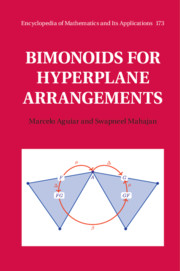Book contents
- Frontmatter
- Contents
- Preface
- Introduction
- Part I Species and operads
- Part II Basic theory of bimonoids
- Chapter 5 Primitive filtrations and decomposable filtrations
- Chapter 6 Universal constructions
- Chapter 7 Examples of bimonoids
- Chapter 8 Hadamard product
- Chapter 9 Exponential and logarithm
- Chapter 10 Characteristic operations
- Chapter 11 Modules over monoid algebras and bimonoids in species
- Chapter 12 Antipode
- Part III Structure theory for bimonoids
- Appendices
- References
- List of Notations
- List of Tables
- Author Index
- Subject Index
Chapter 7 - Examples of bimonoids
from Part II - Basic theory of bimonoids
Published online by Cambridge University Press: 28 February 2020
- Frontmatter
- Contents
- Preface
- Introduction
- Part I Species and operads
- Part II Basic theory of bimonoids
- Chapter 5 Primitive filtrations and decomposable filtrations
- Chapter 6 Universal constructions
- Chapter 7 Examples of bimonoids
- Chapter 8 Hadamard product
- Chapter 9 Exponential and logarithm
- Chapter 10 Characteristic operations
- Chapter 11 Modules over monoid algebras and bimonoids in species
- Chapter 12 Antipode
- Part III Structure theory for bimonoids
- Appendices
- References
- List of Notations
- List of Tables
- Author Index
- Subject Index
Summary
We discuss some basic and important examples of species (relative to a fixed hyperplane arrangement). These include the exponential species, signed exponential species, species of chambers, species of faces, species of flats, species of top-nested faces, species of top-lunes, species of bifaces. They are constructed from well-known objects associated to an arrangement such as faces, flats, chambers, top-nested faces, top-lunes, bifaces. The exponential species is simpler and has all its components equal to the base field. Each of these species carries the structure of a bimonoid. Some of them also admit q-analogues. All these bimonoids arise from universal constructions. We also introduce the Lie species and Zie species. These arise as the primitive part of the bimonoids of chambers and faces, respectively. As a consequence, they carry the structure of a Lie monoid.
Keywords
Information
- Type
- Chapter
- Information
- Bimonoids for Hyperplane Arrangements , pp. 283 - 334Publisher: Cambridge University PressPrint publication year: 2020
